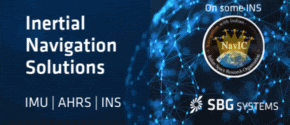| Industry | |
INDUSTRY
Mosaic-G5 GNSS receivers
Septentrio has unveiled mosaic-G5 modules, its smallest GNSS receivers yet, measuring only 23 mm by 16 mm and weighing as little as 2.2 grams. The ultra compact form factor and reduced power consumption of mosaic-G5 receivers enable reliable, high-accuracy positioning. The quad-band mosaic-G5 P3 and the triple band heading module mosaic-G5 P3H bring strong positioning reliability in challenging environments and are tailored for applications such as delivery or light show drones. www.septentrio.com
Students learn Real-World Surveying
A hands-on field exercise on Surveying and Mapping Techniques using the advanced CHCNAV LT800H GNSS tablet concluded successfully, equipping Diploma students of Geomatics Engineering at Military Technological College Oman with practical skills in geospatial data collection, analysis, and map creation.
The intensive exercise helped students to understand key surveying concepts, including types of surveys, GNSS fundamentals, and coordinate systems with a focus on Oman’s national geodetic datum ONGD17. Learners were also trained on ArcGIS Pro, covering data types, symbology, and the field-to-map workflow. Students conducted a site visit and reconnaissance to understand and record difference mapping features in area of interest and set up the CHCNAV GNSS tab to carry out a detailed topographic survey.
FocalPoint partnership with STMicroelectronics
FocalPoint, UK has announced a strategic collaboration with STMicroelectronics. The joint offering provides automotive OEMs a combined solution that enhances navigation performance by improving GNSS reliability and accuracy — key to making autonomous vehicles safer. FocalPoint will integrate its S-GNSS® Auto software, powered by Supercorrelation™technology, onto ST’s Teseo devices, known for their high performance and multi-constellation support. focalpointpositioning.com
New single-card resilient navigation system by Honeywell
Honeywell has launched the HGuide o480, a high-performance, single-card inertial navigation system (INS) engineered to deliver precise, resilient localization and attitude data in an ultra-low size, weight and power package. It can be integrated directly into the electronics stack of a range of applications requiring precise and robust localization. It can also reduce system size and integration complexity, enabling faster deployment and improved performance for unmanned and autonomous systems across air, land and sea. www.honeywell.com
A new era of laser-aided navigation begins
Advanced Navigation has successfully demonstrated a hybrid solution for long endurance GNSS-denied navigation, proving that a software fused inertial-centered architecture is the defining standard for autonomy.
This advancement is achieved by integrating a strategic-grade fiber-optic gyroscope (FOG) inertial navigation system (INS) with a new class of navigation aid: a Laser Velocity Sensor (LVS). The result is a fused hybrid architecture that delivers unprecedented precision and reliability in even the most challenging environments.
At the center of every reliable navigation platform is a trusted source of truth: the INS. Advanced Navigation’s FOG INS, which is sensitive enough to detect the Earth’s rotation, provides that foundation by delivering precise attitude. Complementing this, the LVS uses infrared lasers to measure a vehicle’s ground relative 3D velocity with exceptional accuracy and long-term stability. Unlike conventional sensors, LVS performs reliably on both ground and airborne platforms, as long as it maintains a clear line of sight to the ground or a stationary surface. www.advancednavigation.com
Hi-Target and GMV form alliance
Hi-Target and GMV have established a strategic alliance to jointly develop integrated differential service solutions. By combining their complementary technologies, including user-grade GNSS hardware, correction services, and augmentation infrastructure, Hi Target and GMV will facilitate the adoption of high-precision positioning across various industries and geographic regions. www.gmv.com
Taoglas launches Thunder Series antenna enclosures
Taoglas has launched its new Thunder Series — a high-performance outdoor antenna enclosure platform engineered to support direct integration and installation of industrial routers within the antenna package. Designed for demanding outdoor environments, the series helps engineers optimize installations, reduce signal loss, and significantly lower deployment costs. www.taoglas.com
Visual-aided navigation system for GPS-compromised flights
Inertial Labs has launched a visual aided inertial navigation system (VINS) that enables aircraft to maintain accurate flightpaths when no reliable GPS/GNSS signal is available.
The launch comes as the U.S. Department of Transportation (DOT) reports an increase in GPS signal jamming and spoofing in North America and much of Western Europe. This affects commercial and military operations, with up to 700 global GPS spoofing and jamming incidents taking place daily. VINS enables Unmanned Aerial Vehicles (UAVs) to accomplish very long-range missions in the most GNSS challenged environments. VINS uses a robust 3D vision-based positioning software from Maxar® Raptor™ to estimate a vehicle’s absolute 3D position by applying Perspective and Point (PnP) principles to compare patterns captured from an onboard camera (day or infrared) with satellite imagery-derived Maxar Precision3D™ maps. inertiallabs.com
Anti-jamming antenna for critical, marine, and defence use
Calian GNSS has launched its next generation anti-jamming controlled reception pattern antenna (CRPA). The CR8894SXF+ is an advanced CRPA, purpose-built to provide efficient interference protection and real-time situational awareness across critical infrastructure, marine, and defence environments where GNSS continuity is mission critical. The CRPA is specifically-designed to provide a low power and lightweight solution in a compact size. www.calian.com
ASTRADIA: daytime star tracker for robust, reliable navigation
Sodern has launched Astradia: a daytime star tracker capable of aiding navigation systems, making them independent of GNSS radio-navigation signals.
Sodern is an endo-atmospheric star tracker which, when combined with an inertial navigation system (INS), provides daytime and nighttime attitude measurement, in order to guarantee precise, robust and reliable on-board geo-positioning data.
This high-performance tracker is thus autonomous, no longer reliant on radio navigation signals, and aims to counter the natural drift in inertial navigation systems. It also offers the advantage of emitting no waves, which could otherwise expose an aircraft to detection. sodern.com
Peak System unveils PCAN-GPS Pro FD
PEAK System has introduced the PCAN GPS Pro FD, a configurable sensor module for measuring the position, attitude and acceleration of objects. It has a robust aluminum housing suited for measurement in harsh environments. The device is equipped with a powerful microcontroller (M7/M4 dual-core), a magnetic field sensor, a three-axis gyroscope, a three-axis accelerometer, and the u-blox NEO M9N satellite receiver for GPS, Galileo, BeiDou, GLONASS, SBAS and QZSS. It delivers satellite navigation measurement data with update rates of up to 25 Hz. www.peak-system.com
u-blox launches triple band GNSS module
u-blox has expanded its ZED form factor portfolio with the ZED-F20P, a L1/L2/L5 triple-band GNSS module designed for high precision applications in ground and air robotics. It delivers deterministic, centimeter-level RTK and PPP-RTK accuracy tailored to the needs of lightweight and dynamic platforms. Its end-to-end silicon-to f irmware architecture supports 25 Hz update rates, robust security features, and low power consumption in a streamlined design. www.u-blox.com
Silicon Sensing and Kongsberg Discovery unite with disruptive ambitions
Silicon Sensing Systems Ltd and Kongsberg Discovery AS have signed a co-operation agreement to develop next generation MEMS-based gyro technology that will disrupt existing solutions. This agreement will merge the engineering skills of both companies to speed the evolution of products within each company. siliconsensing.com
Leidos using quantum technology to thwart GPS jamming
Leidos is developing an alternative navigation technology that measures variations in the Earth’s magnetic f ield and harnesses the quantum properties of nitrogen in diamonds. Quantum sensing uses microscopic particles that can simultaneously exist in multiple states to more accurately detect aspects of geophysical properties like magnetic fields. The sensor is being developed by Frequency Electronics, Inc. under subcontract to Leidos and in collaboration with MIT Lincoln Lab. Ultimately, Leidos intends to fly a MagNav system with the new magnetometer. If successful, the technology has the potential to significantly advance navigation technology for military use. www.leidos.com
PTx Trimble unveils next gen guidance controller
PTx Trimble, formed as a joint venture in 2024 by AGCO and Trimble, is providing a new GNSS receiver for precision autoguidance: the NAV-960 guidance controller. The agriculture controller improves positioning accuracy and availability to deliver greater uptime while providing the computing power to support complex field operations and handle future developments. ptxtrimble.com
Leica Geosystems launches mobile mapping solution
Leica Geosystems has launched the Leica Pegasus TRK300, designed for various mobile mapping applications. It features a multi-beam scanner system with two scanning heads that quickly collect high-resolution data from multiple angles, minimizing data gaps. With a range of up to 300 meters, the system covers wide corridors and large open areas, reducing the need for multiple passes. This capability allows users to map more ground in less time without sacrificing data quality, resulting in a high-density point cloud suitable for asset mapping and smart city modeling. leica-geosystems.com
Safran launches of Skylight
Safran Electronics & Defense has launched Skylight, a multi-mode military GNSS receiver designed to withstand electronic warfare threats. It marks a major milestone as the world’s f irst GNSS receiver flight-tested with compatibility for Galileo PRS (Public Regulated Service). Its performance was validated during flight trials aboard a combat aircraft. This receiver delivers encrypted, spoofing-resistant PRS signals, significantly enhancing security for operations in contested environments.
The GNSS receiver is also M-Code compatible, ensuring interoperability with U.S. and allied military systems. www.safran-group.com
Real-time GNSS RFI display for GPS jamming and spoofing detection
SeRo Systems announced that it is expanding its portfolio with the launch of its newest monitoring technology for improved aircraft situational awareness. The live GNSS RFI Situation Display (GRSD) is the first and only real-time solution that combines live air traffic information with SeRo’s advanced GPS jamming and spoofing detection and short-term predictive alerts — offering enhanced visibility into the airspace. www.sero-systems.de
Juniper Systems adds RTK precision to Archer 4 GNSS Expansion Pod
Juniper Systems Inc. has announced that the GNSS Expansion Pod for the Archer 4 Rugged Handheld is now RTK capable. It is also launching a new application for the Archer 4 called Archer Connect. The Archer 4 with GNSS Expansion Pod and RTK connection is now an all-in-one centimeter mapping solution. junipersys.com
ComNav launches laser scanner
ComNav Technology has released the SinoGNSS LS600 laser scanner, a handheld 3D scanning device designed for professional use in both indoor and outdoor environments. It integrates lidar, GNSS, an inertial measurement unit (IMU) and dual-camera systems for detailed, colorized point clouds and precise positioning data production. It also includes advanced SLAM algorithms, which work in tandem with a built-in real-time kinematic (RTK) GNSS module. This combination allows the scanner to achieve centimeter level accuracy, even in challenging enviornments. www.comnavtech.com
oneNav unveils world’s f irst L5-direct™ ASIC
oneNav has announced the successful bring-up of the world’s first L5-direct™ GNSS receiver ASIC. It is completely independent of vulnerable L1 signals, was rapidly developed and deployed leveraging the advanced GlobalFoundries (GF) 22nm FDX™ platform, benefiting from its exceptional mixed-signal capabilities and ultra-low power performance for both RF and digital domains. Its L5-direct utilizes a novel “GPU for GNSS” processor architecture that directly acquires and tracks L5 signals without relying on L1 signals, which are widely susceptible to jamming and spoofing—a critical vulnerability for aviation, defense, and consumer GNSS applications. onenav.ai
OS chooses KOREC and Trimble R980
KOREC will be supplying Ordnance Survey (OS) with 180 Trimble R980 GNSS Receivers. These receivers will be supported by KOREC for the duration of the five-year contract. The receivers brings together several top Trimble GNSS technologies and are particularly suitable for OS. www.ordnancesurvey.co.uk
New standard for long endurance aerial missions
DJI has unveiled the Matrice 400 – UAV that offers a maximum flight time of 59 minutes and can carry payloads weighing up to 6 kg. It is equipped with a lidar and millimeter wave radar-based obstacle sensing system, enhancing its ability to navigate complex environments. It features an IP55 protection rating, allowing it to operate in harsh conditions and withstand extreme temperatures ranging from minus 20°C to 50°C, according to DJI. www.dji.com
Dragoon selects Teledyne FLIR Prism software
Teledyne FLIR OEM has announced Dragoon is using the Prism™ Supervisor and Prism SKR software for its AI-driven object detection, tracking, real-time autonomy flight control, and mission planning capabilities within its long-range unmanned platform prototypes under Project Artemis, a Defense Innovation Unit (DIU) initiative.
Project Artemis is a program designed to evaluate and deploy long-range loitering munitions capable of operating in highly contested electromagnetic environments and in large numbers. Dragoon is one of four organizations within Project Artemis tasked to demonstrate low-cost, adaptable, long range, unmanned aerial systems (UAS) platforms with the potential to maximize operational flexibility. www.flir.in












 (No Ratings Yet)
(No Ratings Yet)





Leave your response!